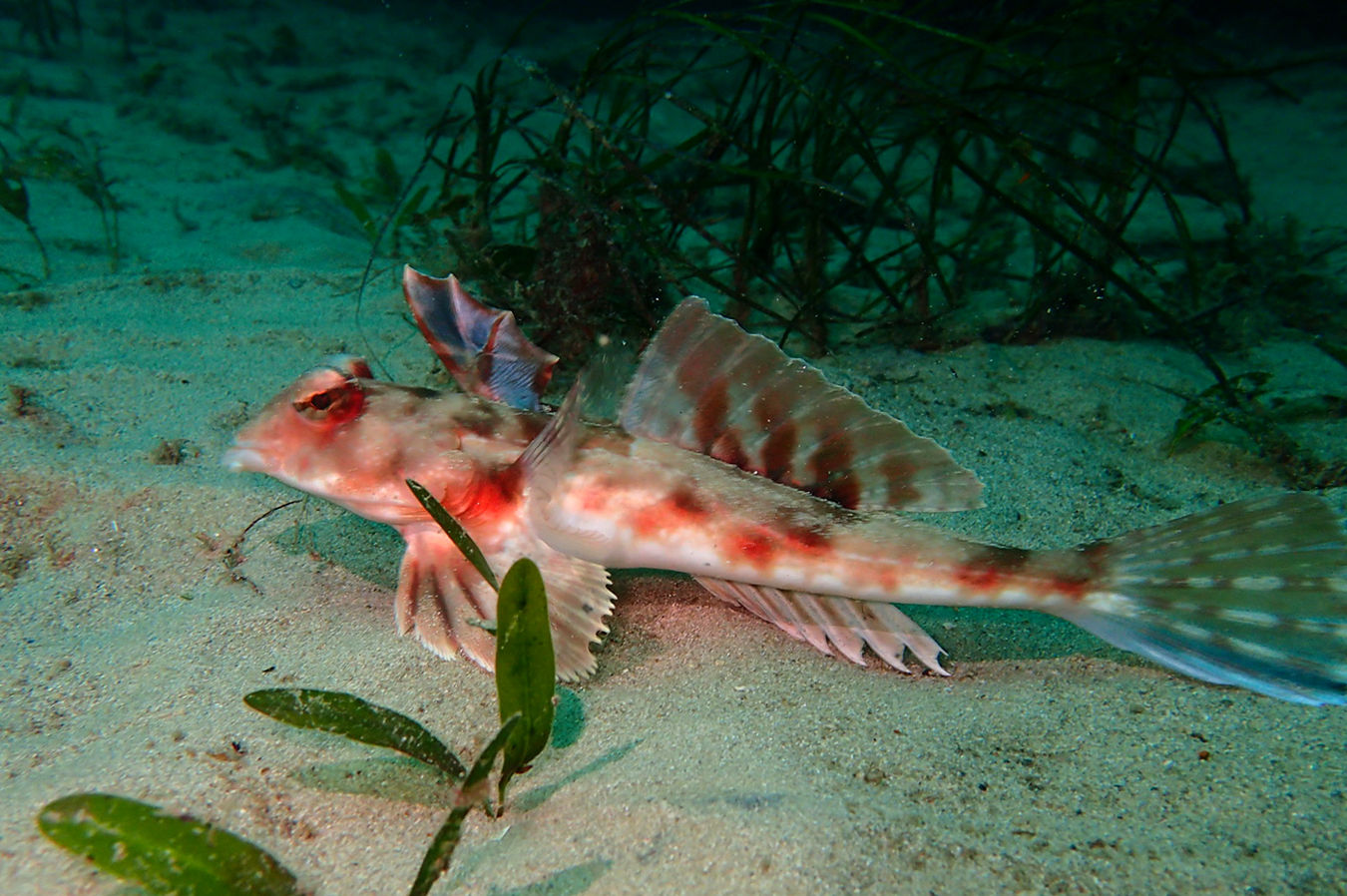- Classification
- ACTINOPTERYGII
- PERCIFORMES
- CALLIONYMIDAE
- Foetorepus
- calauropomus
Common Stinkfish, Foetorepus calauropomus (Richardson 1844)
Other Names: Crookspined Dragonet, Crook-spined Dragonet, Hooky

A Common Stinkfish, Foetorepus calauropomus, at the Glenelg Dredge wreck, Gulf St Vincent, South Australia, April 2017. Source: scubawayne / iNaturalist.org. License: CC by Attribution-NonCommercial
Summary:
A well camouflaged, brown to orange or reddish stinkfish with darker brown mottling above, a whitish underside, and blue spots on cheeks. Males have many small black blotches on head, body, and fins.
Cite this page as:
Bray, D.J. 2024, Foetorepus calauropomus in Fishes of Australia, accessed 18 Apr 2024, https://fishesofaustralia.net.au/home/species/43
Common Stinkfish, Foetorepus calauropomus (Richardson 1844)
More Info
|
Distribution |
East of Coolum, Queensland, around southern Australia, to north of Rottnest Island, Western Australia, including Tasmania. The species may also occur in New Zealand. Inhabits shelly, sandy, muddy areas and seagrass beds in bays, estuaries and coastal waters, in depths of 15-183 m. |
|
Features |
Dorsal fin IV + 8; Anal fin 7; Caudal fin 9; Pectoral fin 18-22; Pelvic fin I, 5. Body long, slender, tapering towards tail, eyes close together on top of head; mouth small, opening forward and downward; dorsal fins separate; pelvic fins large, arising well before pectoral-fin base. Caudal fin elongate, in males with 4 to 6 medial filaments; in females convex, without filaments. Preopercular spine with a dorsal point additionally to main tip, but without an antrorse spine at its base. First dorsal fin not much higher than second dorsal fin. |
|
Colour |
Dorsal sides of head and body brown to orange or reddish darker brown mottling above, ventral side white. Males with many small black blotches on head, body, and fins; females without black blotches. |
|
Remarks |
The common name 'stinkfish' refers to the acid smell of the slime on the body, which tastes bitter and may be toxic. |
|
Etymology |
The specific name calauropomus is from the Greek kalaurops (= a herdman's crook, a shepherd’s staff) and poma (= cover, lid), in reference to the long spines on the gill cover (preopercular spines) described as having “two teeth at the summit, the interior one being recurved, so that the whole spine has a resemblance to a shepherd’s crook” |
|
Species Citation |
Callionymus calauropomus Richardson 1844, Zool. Voy. Erebus Terror 1839–43 2: 10, pl. 7(4-5). Type locality: Western Australia. |
|
Author |
Bray, D.J. 2024 |
|
Resources |
Common Stinkfish, Foetorepus calauropomus (Richardson 1844)
References
De Vis, C.W. 1883. Description of two new Queensland fishes. Proceedings of the Linnean Society of New South Wales 1 7(4): 620-621 (described as Callionymus achates, type locality Queensland) See ref at BHL
Fricke, R. 1981. Revision of the genus Synchiropus (Teleostei : Callionymidae). Theses Zoologicae 1: 194 pp, 1-46 figs (as Synchiropus calauropomus)
Fricke, R. 1983. Revision of the Indo-Pacific genera and species of the dragonet family Callionymidae (Teleostei). Theses Zoologicae 3: 1-774 figs 1-212 (as Synchiropus (Synchiropus) calauropomus)
Fricke, R. 2000. Callionymidae of New Caledonia, with remarks on related species and descriptions of 10 new species from New Caledonia, Australia, New Guinea, and Hawaii (Teleostei). Stuttgarter Beiträge zur Naturkunde. Serie A (Biologie) 617: 1-81 figs 1-35 (as Synchiropus calauropomus)
Fricke, R. 2001. Suborder Callionymoidei. pp. 3549-3573 in Carpenter, K.E. & Niem, T.H. (eds). The Living Marine Resources of the Western Central Pacific. FAO Species Identification Guide for Fisheries Purposes. Rome : FAO Vol. 6 pp. 3381-4218.
Fricke, R. 2002. Annotated checklist of the dragonet families Callionymidae and Draconettidae (Teleostei: Callionymoidei), with comments on callionymid fish classification. Stuttgarter Beiträge zur Naturkunde. Serie A (Biologie) 645: 1-103. (as Synchiropus calauropomus)
Gomon, M.F., Glover, C.J.M. & Kuiter, R.H. (eds) 1994. The Fishes of Australia's South Coast. Adelaide : State Printer 992 pp. 810 figs.
Gomon. M.F. & Yearsley, G.K. 2008. Family Callionymidae. pp. 742-746 in Gomon, M.F., Bray, D.J. & Kuiter, R.H. (eds). Fishes of Australia's Southern Coast. Sydney : Reed New Holland 928 pp.
Johnson, C.R. 1971. Revision of the callionymid fishes referable to the genus Callionymus from Australian waters. Memoirs of the Queensland Museum 16(1): 103-140 figs 1-26 (as Callionymus calauropomus)
Johnson, J.W. 2010. Fishes of the Moreton Bay Marine Park and adjacent continental shelf waters, Queensland, Australia. pp. 299-353 in Davie, P.J.F. & Phillips, J.A. Proceedings of the Thirteenth International Marine Biological Workshop, The Marine Fauna and Flora of Moreton Bay. Memoirs of the Queensland Museum 54(3)
Kuiter, R.H. 1993. Coastal Fishes of South-eastern Australia. Bathurst : Crawford House Press 437 pp.
Last, P.R., Scott, E.O.G. & Talbot, F.H. 1983. Fishes of Tasmania. Hobart : Tasmanian Fisheries Development Authority 563 pp. figs.
May, J.L. & Maxwell, J.G.H. 1986. Trawl fish from temperate waters of Australia. CSIRO Division of Fisheries Research, Tasmania. 492 pp.
Nakabo, T. 1982. Revision of genera of the dragonets (Pisces : Callionymidae). Publications of the Seto Marine Biological Laboratory 27(1/3): 77-131 figs 1-30
McCoy, F. 1890. Prodromus of the Zoology of Victoria. Decade 20. Melbourne : George Robertson Vol. 2 329-375 pls 191-200. (Plate 192, P. 333, Callionymus calauropomus) See ref at BHL
Richardson, J. 1844. Ichthyology. pp. 1-16 pls 1-6, 7-8 (parts), 9-10 in Richardson, J. & Gray, J.E. (eds). The Zoology of the Voyage of H.M.S. Erebus and Terror under the command of Captain Sir James Clark Ross, R.N., F.R.S., during the years 1839–43. London : E.W. Janson Vol. 2 139 pp. See ref online
Struthers, C.D. 2015. 219 Family Callionymidae, pp. 1556-1559 in Roberts, C.D., Stewart, A.L. & Struthers, C.D. (eds). The Fishes of New Zealand. Wellington : Te Papa Press Vol. 4 pp. 1153-1748.
Whitley, G.P. 1931. New names for Australian fishes. The Australian Zoologist 6(4): 310-334 1 fig. pls 25-27 See ref at BHL








